Two Miocene Hipparion species identified from Shihuiba locality of Lufeng, Yunnan, China
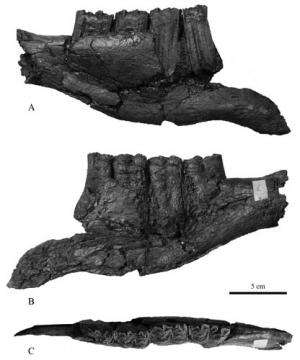
The Shihuiba locality (Lufengpithecus site) at Lufeng, Yunnan is one of the most important Miocene mammal fauna sites in China. The Hipparion (three-toed horse) fossils collected from this locality from 1975 to 1983 were identified as Hipparion sp. 1 and Hipparion sp. 2. Recently, SUN Boyang, a graduate student paleontologist of Institute of Vertebrate Paleontology and Paleoanthropology (IVPP), Chinese Academy of Sciences, re-examined these specimens and found they represent two species, Hipparion theobaldi (Lydekker, 1877) and Hipparion (Hipparion) lufengense sp. nov. The study published in the latest issue of Vertebrata PalAsiatica 2013(2) indicated that both species immigrated from the Siwaliks to Yunnan when climate and environment changed, providing new data for studies on paleobiogeography.
Hipparion theobaldi is a common hipparionine species in South Asia. It is a very large-sized hipparionine horse. Protocones of the Shihuiba specimens are small and rounded, different from those of the Siwaliks specimens, which are elongated with a flattened lingual side. The specimens of H. theobaldi in Yuanmou, Yunnnan and the Irrawaddy Group of Myanmar are similar to the Lufeng specimens in protocones. The ages of the Yuanmou and Lufeng mammals are later than those of Siwaliks. So H. theobaldi in Yunnan might come from the Siwaliks. H. theobaldi in Yunnan and Myanmar might become a population within a species which is different from H. theobaldi in the Siwaliks.
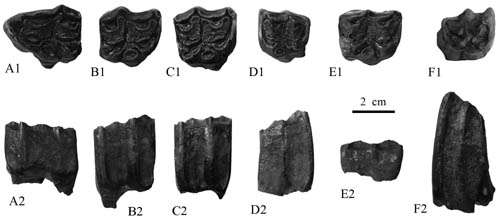
The height of cheek tooth crown of H. theobaldi in the Siwaliks was increasing from the Lower to Upper Dhok Pathan Formation. The crown height of H. theobaldi in Middle Dhok Pathan is similar to those in Yuanmou and Lufeng. The age of Middle Dhok Pathan Formation was about 8-6 Ma. The age of the Yuanmou locality is 8.2-7.2 Ma. The age of the Lufeng locality is 6.8-6.2 Ma. The environment of the Siwaliks changed and grassland was dominant at 7.37-6.76 Ma, while forests were dominant at Lufeng at that age. It is probable that H. theobaldi in the Siwaliks evolved to hypsodont to adapt to coarse food and meanwhile tried to seek a comfortable habitat where grass was soft.
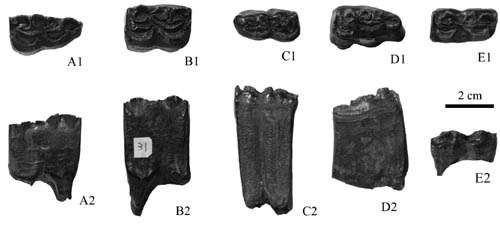
Hipparion (Hipparion) lufengense sp. nov. is a small-sized hipparionine horse. Its characters are quite different from those of the Old World and Africa. Most of the Old World Hipparion are medium-sized to large-sized, and the small-sized species have no similarity with the Lufeng specimens in cheek teeth. The North American hipparionine horses have four genera, and each of them has very special characters, which are completely different from the Lufeng specimens. Among all Hipparion specimens, the Siwaliks specimen (AMNH 19492) is the most similar one to the Lufeng specimens. Both of them are small-sized and have very complex plications on cheek teeth. So Siwaliks specimen (AMNH 19492) should be assigned to H. (H.) lufengense.
-
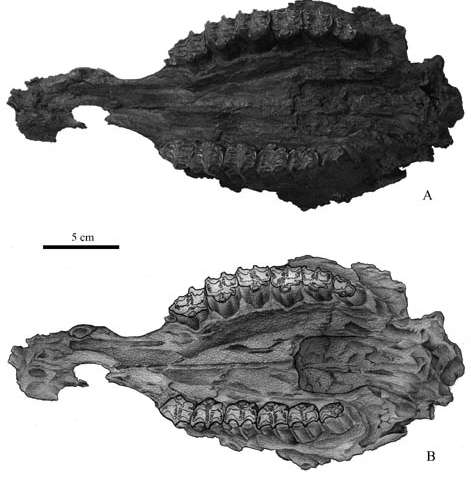
Fig.4 Photo (A) and sketch (B) of Hipparion (Hipparion) lufengense sp. nov., holotype, IVPP V 18531, in ventral view. Credit: SUN Boyang -
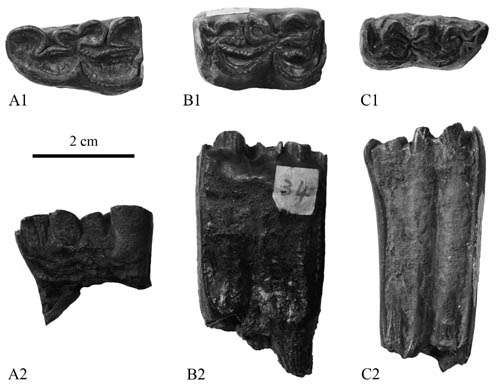
Fig.5 Lower cheek teeth of Hipparion (Hipparion) lufengense sp. nov. Credit: SUN Boyang
The plications of H. (H.) lufengense are relatively straight, and have very thick enamel. These characters might adapt to coarse food. But in the habitat of H. (H.) lufengense, the forests were dominant. This situation seemed to be a paradox. H. (H.) lufengense evolved to complication in cheek teeth to adapt to coarse food when the environment of Siwaliks changed greatly, and meanwhile tried to seek a more comfortable habitat where grass was soft. So it is reasonable that H. (H.) lufengense in the Siwaliks immigrated to Yunnan when climate and environment changed.
More information: www.ivpp.cas.cn/cbw/gjzdwxb/xb … 0507383338265913.pdf
Journal information: Vertebrata PalAsiatica





















